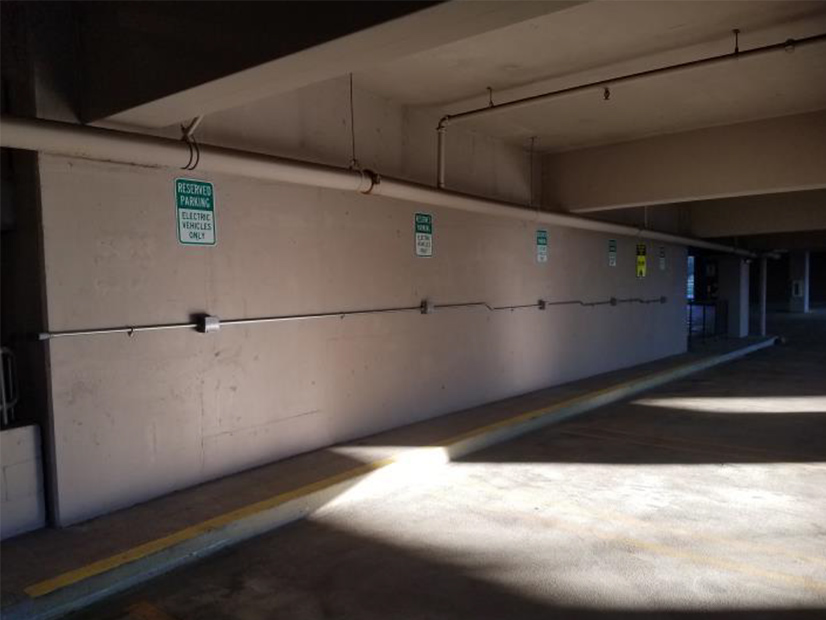When it comes to increasing the availability of electric vehicle charging at apartment complexes, Level 1 charging is a big part of the solution, according to speakers at a webinar on EV charging equity in California.
With a 10-hour overnight charge, a Level 1 charger provides 40 to 50 miles of range — enough for most residents’ daily needs, said Peter Ambiel, energy programs specialist with Peninsula Clean Energy. PCE is a community choice aggregation program serving San Mateo County.
But the tendency is to overbuild charging stations at multi-unit housing complexes, Ambiel said Friday during a webinar hosted by the California Community Choice Association (CalCCA). The group represents the state’s community choice electricity providers.
“They’re putting too much capacity per port, which incurs extra costs,” Ambiel said. “You don’t need to put as much power into these stations because you meet drivers’ daily needs with a much lower threshold.”
Cost Differences
As an example, Ambiel presented a case study of installing 17 EV charging ports at a San Mateo County apartment complex. The cost for equipment and installation of 15 Level 1 stations plus two Level 2 stations would be $90,600. The cost if all 17 stations were Level 2 would be $251,500, or possibly higher if a new transformer were needed.
Because most apartment complexes assign parking spaces to their residents, a complex would ideally provide a Level 1 charger at every assigned space, Ambiel said. In addition, an apartment complex might want to provide Level 2 charging in shared spaces for occasions when a resident wants to charge up for a longer trip.
Level 1 charging is especially important for older or smaller multi-unit complexes, Ambiel said, because it may allow them to avoid significant panel or transformer costs.
PCE is running a $28 million electric vehicle charging infrastructure program called EV Ready, which aims to install 3,500 charging ports in San Mateo County over four years. The program includes a target of 1,075 Level 1 and 335 Level 2 charging stations at multi-unit housing complexes.
EV Charging Disparities
Electric vehicle charging is frequently not available at multi-unit housing complexes, which are often home to lower-income residents. About 30% of Californians, or more than 10 million people, live in multi-unit housing, according to the webinar presentation.
In the San Francisco Bay Area, about 60% of residents live in multi-unit housing, but only 10% of electric vehicles are owned by people living in multi-unit housing, according to webinar speaker Sherry Bryan, a program manager with Ecology Action.
“That’s a huge disparity,” Bryan said.
Providing EV charging for residents has no return on investment for apartment owners, Bryan said. And EV service providers aren’t that interested in multi-unit complexes, where the amount of charging may be less than at workplaces or charging destinations, she said.
“If you want to increase equity, especially [in] affordable housing, coming at the property owner with a no-cost, free installation is probably your best way to go,” Bryan said. “Any kind of cost-share is going to pause the conversation.”
Ecology Action is a nonprofit that offers community programs aimed at reducing greenhouse gas emissions. One of its programs provides free installation of EV charging stations at apartment complexes.
Bryan said EV charging assistance programs shouldn’t require a certain amount of electricity use. It could take as long as a year before residents start using the charging stations, she said, noting that residents may need to save money to buy an EV.
And requiring a minimum number of ports may exclude smaller complexes, Bryan said.
Ecology Action has used EV charging equipment from Plugzio, which allows the property owner to collect payment for electricity used during charging.
Resident Education
Bryan said resident education is an important component of the EV charging programs. Information about EVs can be shared with residents by going door to door or by posting fliers in community spaces such as laundry rooms.
Another strategy is to roll out an electric vehicle during a community event such as a movie night. Many residents may not have seen an EV before, Bryan said. Tenants interested in an EV can be directed to purchase guidance and incentive programs.
Bryan said a question she often hears is why should someone buy an EV in an era of rolling blackouts and power outages. She said a plug-in hybrid may be a good initial choice for some apartment residents, who may rely on a single car.
“That gives the person the flexibility to have gas if they need it, but also to do most of their day-to-day commuting and errands on a battery,” she said.



